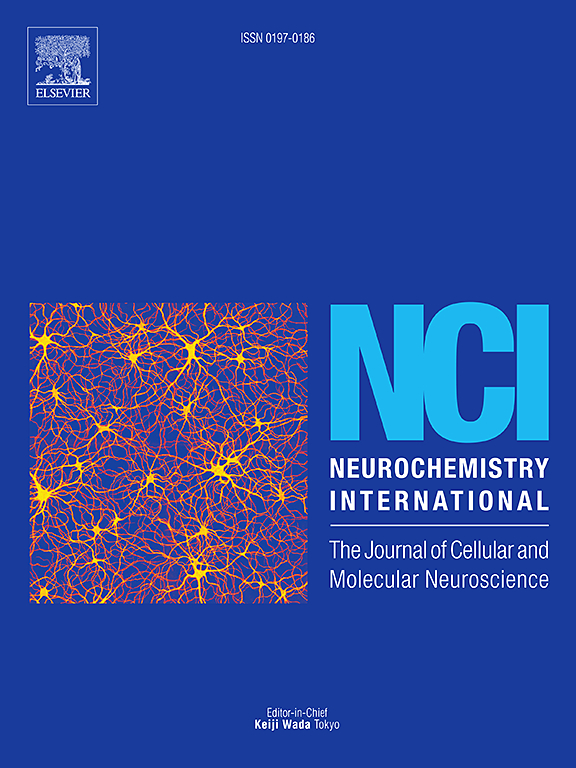Cerebellum KCC2 protein expression plasticity in response to cerebral cortical stroke
IF 4
3区 医学
Q2 BIOCHEMISTRY & MOLECULAR BIOLOGY
引用次数: 0
Abstract
Background
Recent evidence suggests extra-cortical adaptations within the cerebellum may contribute to motor recovery in patients with cortical ischemic strokes. The molecular/cellular adaptations enabling this effect to have not been identified. Chloride transport proteins (NKCC1 and KCC2) are important regulators of neuronal transmission and may underlie adaptive changes following ischemic stroke.
Objective
Examine changes in cerebellar NKCC1 and KCC2 protein expression following cortical ischemic stroke.
Methods
Adult C57BL/6J male mice underwent sham or the left middle cerebral artery occlusion (tMCAo)-induced ischemic stroke. Changes of NKCC1 and KCC2 proteins within the deep cerebellar nuclei (DCN) were assessed by immunofluorescence staining.
Results
tMCAo induced selective infarct lesion in the left striatum and cortex of the stroke mice but not in other brain regions including cerebellum. The inwardly directed chloride transporter NKCC1 was equivocally expressed within bi-hemispheric DCN of both sham control and stroke mice. In contrast, the outwardly directed chloride transporter KCC2 protein expression was significantly higher in the bi-hemispheric DCN of stroke brains, compared to sham controls. Double immunostaining analysis revealed a statistically significant increase in KCC2 intensity within VGLUT-1+ neurons of the ipsilateral DCN of the stroke mice, but not in the VGAT+ neurons.
Conclusions
Ischemic cortical stroke stimulates KCC2 protein expression in the DCN VGLUT-1+ neurons, without a change in NKCC1 protein expression.
脑皮质卒中后小脑KCC2蛋白表达的可塑性
背景:最近的证据表明,小脑的皮质外适应可能有助于皮质缺血性中风患者的运动恢复。导致这种效果的分子/细胞适应尚未被确定。氯离子转运蛋白(NKCC1和KCC2)是神经元传递的重要调节因子,可能是缺血性卒中后适应性变化的基础。目的:探讨皮质缺血性脑卒中后小脑NKCC1和KCC2蛋白表达的变化。方法:成年C57BL/6J雄性小鼠假手术或左大脑中动脉闭塞(tMCAo)致缺血性脑卒中。免疫荧光染色观察大鼠小脑深部核内NKCC1和KCC2蛋白的变化。结果:tMCAo在脑卒中小鼠的左纹状体和皮层有选择性梗死灶,但在小脑等脑区无选择性梗死灶。向内定向的氯离子转运体NKCC1在假性对照组和脑卒中小鼠的双半球DCN中均有模糊表达。相比之下,与假对照组相比,中风脑的双半球DCN中向外定向氯离子转运体KCC2蛋白的表达明显更高。双免疫染色分析显示,脑卒中小鼠同侧DCN的VGLUT-1+神经元内KCC2强度有统计学意义的增加,而VGAT+神经元内KCC2强度无统计学意义的增加。结论:缺血性皮质卒中刺激DCN VGLUT-1+神经元中KCC2蛋白表达,但NKCC1蛋白表达未见改变。
本文章由计算机程序翻译,如有差异,请以英文原文为准。
求助全文
约1分钟内获得全文
求助全文
来源期刊

Neurochemistry international
医学-神经科学
CiteScore
8.40
自引率
2.40%
发文量
128
审稿时长
37 days
期刊介绍:
Neurochemistry International is devoted to the rapid publication of outstanding original articles and timely reviews in neurochemistry. Manuscripts on a broad range of topics will be considered, including molecular and cellular neurochemistry, neuropharmacology and genetic aspects of CNS function, neuroimmunology, metabolism as well as the neurochemistry of neurological and psychiatric disorders of the CNS.
 求助内容:
求助内容: 应助结果提醒方式:
应助结果提醒方式:


